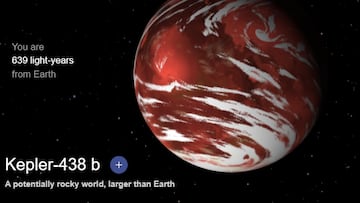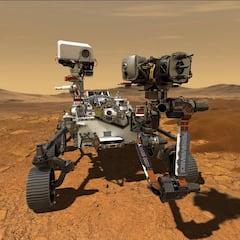What is the probability of Kepler-442b supporting life?
Kepler-442b, one-third larger than Earth and which receives two-thirds of the light that reaches our planet, has a 97% chance of being in a habitable zone.

A team of astronomers recently discovered eight new exoplanets that orbit their stars at a distance that would allow them to have liquid water on their surface, according to National Geographic magazine, opening up the possibility that some of them could be within the “Goldilocks zone” that would permit life to exist. Of those eight, there are two that experts have identified as the most Earth-like exoplanets to date: Kepler438b and Kepler-442b.
In what way do they resemble our planet? Both are exoplanets: that is to say, they orbit around stars, as the Earth does with the Sun. Both do so around two red dwarf stars that are smaller and cooler than our Sun: 438b takes 35 days to orbit its star and 442b a total of 112 days.
According to the estimates of the researchers, 438b has a diameter 12% larger than that of Earth and a 70% chance of being a rocky planet. In addition, it receives 40% more light than our planet, so it has a 70% chance of being within a habitable zone of its star.
"This Goldilocks zone is the region around a star where the energy from the star would keep water liquid on a rocky planet’s surface." Dr. Lisa Kaltenegger (@KalteneggerLisa) #COSMOSCSI #COSMOS 4/ pic.twitter.com/17O7pUKhTu
— Carl Sagan Institute (@CSInst) February 28, 2020
Kepler-442b could be in the “Goldilocks zone”
On the other hand, 442b is a third larger than Earth and has a 60% chance of being made up predominantly of rocks: 442B receives about two-thirds of the light that reaches Earth, so its chances of being in the Goldilocks zone stand at 97%, according to the scientists’ calculations.
However, the simple fact that a planet receives more light doesn’t necessarily mean that it’s more habitable. For the odds to be greater, it is necessary for the right light to reach the entity. For example, if there is a lot of light, any water on the planet would boil and evaporate. If it received too little on the other hand, the water would end up freezing.
“Promising candidates”
Related stories
“We don’t know for sure if any of the planets in our sample are actually habitable. What we can say is that they are promising candidates”, said David Kipping of the Harvard-Smithsonian Center for Astrophysics. Before these two new exoplanets were discovered, the closest celestial bodies to Earth found to date were Kepler-186f (1.1 times larger than Earth and 32% brighter) and Kepler-62f (1.4 times larger than our planet and with 41% more light).
Other known exoplanets include Gliese 667CC (22 light years from Earth, 4.5 times larger and with a 28-day orbit of star), Proxima Centauri B (the closest to Earth, but which has extremely strong ultraviolet radiation) or TRAPPIST-1E, which presents very encouraging conditions because its core consists chiefly of iron.

